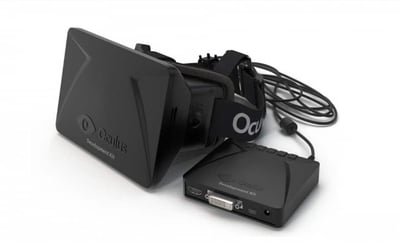Ian Hall (IH) is the Chief Product Officer of Yulio Technologies. He leads Yulio’s vision of VR as a practical, everyday business tool and the perfect medium for visual storytelling. Ian is also the Co-founder of Pixel Tours Inc., a design consultancy specializing in human factors engineering and development.
We sat down with Ian to talk about his experience in digital visual storytelling, and where VR is going.
Tell us a bit about how you got into the industry.
IH: The founders of Yulio have been doing graphic-powered business applications for the better part of 20 years.
So, graphic-powered applications are all about visual tools and visual storytelling - it really means things like in the “dot.com boom” days, we developed an image server that let you do zooming, spinning and all that kind of stuff, and we were first in the world to do that. It eventually got bought out by Adobe, and powered half of the e-commerce sites being built when e-commerce was just getting off the ground. Then, we built a web-based shelving layout tool for a Fortune 500 company, like one of those BIG brands - the guys who are always laying out their products on grocery store shelves, and of course, you need to do it visually first, so we built them a tool to do that. We did an online classified ads engine, “Trader Media”, which was the Canadian branch of Auto Trader, and they had the biggest network of classified ads in the country at that time. We built an entire imaging platform for them to create online ads where users could spin the car to see all angles and zoom in. We taught them how to capture the photographs and create a web presence for the photos. They ended up getting bought out for over 400 million dollars and the buyer actually cited the implementation of the imaging and their web-presence as their main reasons that they saw that much value in the business.
So how did that bring you to VR?
IH: The imaging software we built was amazing quality. We’ve done 360-degree tours for real estate, and we’ve done 3D renders and pipelines for architecture and commercial furniture. So, all of that has one thing in common, which is that there is a customer who’s trying to understand what it is they’re ultimately going to be getting, while not being in the room with the thing. Every one of those shows you exactly the same underlying root pain for the buyer and a seller who wants to answer that pain with visual storytelling. We’ve been doing this for 20 years - and every one of those solutions had something in common. They’re imperfect.
“We’ve been doing this for 20 years, and every one of those solutions had something in common... They’re imperfect… [but] VR takes it to another level; It takes an imperfect medium and gets it a hell of a lot closer to perfect.” - IH
They’re all attempting to use visual storytelling techniques to convey what it's like to be in the room with whatever you’re talking about - well you can't do it. VR takes it to another level - It takes an imperfect medium and gets it a lot closer to perfect - and THAT'S why the moment this kind of thing came to maturity we jumped on it because we have been experiencing this pain on our customers’ behalf and coming up with imperfect solutions for decades. This is the first real massive leap forward in visual storytelling.
So to get to the root of it, VR is the difference between looking at the floorplan of a room and standing in it, and you can apply that same kind of parable to every other one of those points. And it goes back to things like scale, volume, emotional connection - and in every single one of the projects we’ve been involved with, helping people understand those things is exactly what we’ve been trying to achieve. For us, VR was the new way to achieve all of those things, and it has finally become simple enough that it makes sense for business.
So, what’s Yulio’s take on that?
IH: Yulio is turnkey digital reality. It is a platform that designers and marketers, and anyone else who uses visual storytelling to sell their products, can use to present their ideas and products in a way that their customers completely and instantly understand.
Unpacking that a little bit, it’s turnkey, which means end-to-end. So, we’ve got all of the building blocks so you don't have to go and cobble together a bunch of assets - you can turn us on and you’ve got everything you need. You’ve got content creation, content management, publishing, distribution, you’ve got a way of delivering the experience on every major mobile platform - in other words, the applications on the devices that people actually use for that stuff, the closed loop, the business analytics, the presentation tools, the collaborative tools - it’s all under the same umbrella. So, turnkey, simple, and enterprise scale - this stuff works, it was designed from the ground up to be simple to use, and, it’s not for the consumer market - this is a business-centric product, which means that everything I've talked about is enterprise-grade security, performance, reliability, and all those hallmarks that a good CIO is going to be looking for their practice.
In terms of the customers, we created this originally for the architecture and design community, but that’s been evolving. We now have customers in construction, we have customers in real estate, product sales, product marketing - so as the technology is gaining acceptance, getting more exposure, and more winning scenarios are coming forward, it’s moving more and more into a broader business community.
Ok, now pulling you away from the business side of things - What was your first experience with VR?
IH: So, back in the mid-90’s was kind of the first renaissance of VR. There was consumer-grade, arcade-style virtual reality where you put on a big clunky helmet, the tracking was terrible, and it was kind of like vector graphics, but it moved with you and it gave you kind of a sense of immersion, and you could kind of get a taste of what’s coming, but it never made it out of the arcade. It was too expensive, too clunky, and content creation just wasn’t there - and a lot of the hardware building blocks and software building blocks just weren’t there either. Previous to that, I had been actually involved in an industrial design company and we got invited to a private showing of a little display chip, and there were, at the time, two of these ON THE PLANET. They brought it out of the lab - and this is from one of the big silicon valley manufacturers - they literally built this prototype in their lab, it was maybe a centimeter and a half across, and it was a high-definition functional display - the first of its kind on planet Earth - and we got to see it, and that was even before this VR stuff came out. So, I was sitting there, looking at this thing with the mad scientist who had actually created it….and it's worth millions of dollars because there were only two of them, and you could see the potential even then. You can trace the Oculus Go optics, and the Hololens and the Google Glass - all of those underlying technologies back to this chip which was incredible. It was compressing high-quality visuals and streaming into this tiny little display technology that was ultimately wearable - and that's gotta be 25 years ago. So, it’s taken a while for all of these little building blocks to form, but they’re finally all coming together.
“So, we were very well positioned to take advantage of this disruptive technology just because we knew what we were looking for - we knew what the blockers were, we knew what success looked like and we knew what imperfection looked like, so we kinda knew what the gaps were in the existing ecosystem.” - IH
My first true exposure to VR was when the Oculus DK1 came out - that was the first legitimately featured consumer headset that came out and we were all over it as soon as it launched.

We had prototypes of what became Yulio going within days of it getting out there. So, we were very well positioned to take advantage of this disruptive visual storytelling technology just because we knew what we were looking for - we knew what the blockers were, we knew what success looked like and we knew what imperfection looked like, so we kinda knew what the gaps were in the existing ecosystem.
In the end, all the hardware and technology has to be about visual storytelling or it falls flat. Basically, if you use still images, catalogs or brochures to tell your story today, you can do it better with VR.
We’d like to thank Ian Hall for sitting with us and sharing some of his experiences and knowledge of the industry! Ian recently did a podcast about practical and business-ready virtual reality, and where he sees the visual storytelling market going in the future. You can listen to it here! Interested in learning more about the digital reality industry and how your business can get involved? Ian was also the driver on our free 5-day VR email course! Sign up here to begin your crash-course surrounding practical business-ready VR, industry trends, and budget considerations!




.jpg?width=245&height=150&name=active-adult-beautiful-1799244%20(1).jpg)
